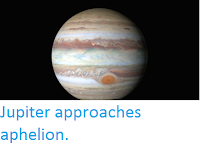The planet Jupiter reached opposition (directly opposite the Sun) at 7.46 am GMT on Tuesday 14 July 2020. This means that it was at its closest to the Earth this year, about 4.45 AU (4.5 times the
average distance between the Earth and the Sun, or about 666 400 000
km), and completely illuminated by the Sun. While it is not obvious to
the naked eye observer, the planets have phases just like those of the
Moon; being further from the Sun than the Earth, Jupiter is 'full' when
directly opposite the Sun.
The orbit and position of Jupiter and the planets of the Inner Solar System on 14 July 2020. In the Sky.
While the relative positions of the planets have no direct influence on
life on Earth, the opposition of Jupiter does present the best
opportunity for observations of the planet by Earth-based observers. On Tuesday 14 Jupiter will appear as a bright object in the
constellation of Sagittarius, It will be above the horizon between about 10.00 pm and 4.00 am local time from most places on Earth reaching a maximum elivation at about 1.00 am. Seen
through a moderate sized telescope both the planet and its larger moons
should
be visible, though it will be fairly close to the Moon, which will
impair viewing slightly.
The relative positions in the sky of Jupiter, Saturn and Pluto on Tuesday 15 July 2020; Pluto will reach opposition on 16 July and Saturn on 20 July. Earth Sky.
See also...
Follow Sciency Thoughts on Facebook.








